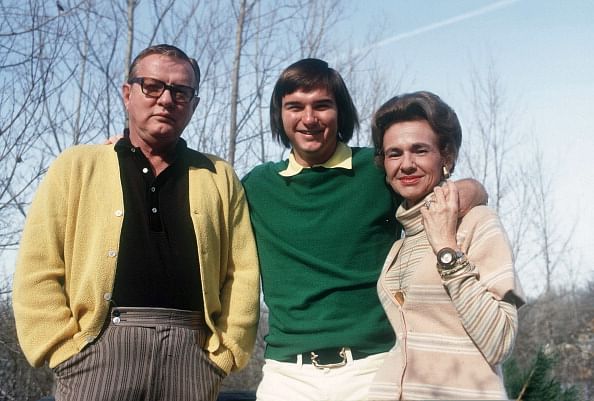
A tribute to tennis's most famous mothers
Tennis dads are back in the spotlight thanks to the recent indiscretions of Bernard Tomic‘s father. John Tomic is not the first tennis dad to put their child’s career in peril. He joins the infamous ranks of Jim Pierce, Peter Graf, Damir Dokic and Arsalan Rezaï, who have all been in the spotlight for their poor behaviour on and off the court. But for today, let’s step away from the fathers and talk about the mothers. On the occasion of Mother’s Day, here’s a look at the four tennis moms who have played an influential role in their child’s career, moulding them into champions.
Gloria Connors
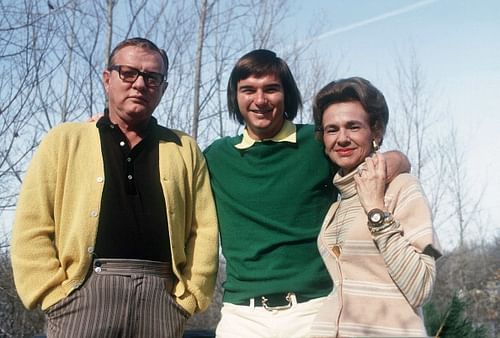
Jimmy Connors (c) and his mother Gloria Connors (r)
It’s not common for a male tennis player to be coached by a woman, even rarer when that woman is his mother. But Gloria Connors broke that stereotype as she coached her son Jimmy to tennis greatness in the 1970s. Gloria, once America’s No. 13 junior and a competitor at the U.S. nationals twice, was responsible for teaching Jimmy not only the basic techniques and strokes that would set Connors’ game apart but also his fierce competitive me-against-the-world attitude which would become the trademark of his long career.
As Connors writes in his upcoming autobiography, Gloria and her mom Brenda, taught him “a woman’s game, but given to a man to beat men.” Connors rebukes the stereotypes that mothers cannot they teach their sons tennis. “Why was it OK for Joe Montana’s dad to teach his son football or Wayne Gretzky’s dad to teach him hockey but it wasn’t OK for Gloria Connors to teach her son tennis?”
Jimbo went on to become one of the sports’ all-time greats, winning eight Grand Slam singles titles and was no. 1 for a then-record 160 consecutive weeks from July 1974 to August 1977. And Connors still holds one record that is unlikely to be broken – the most number of ATP titles at 109. Gloria’s impact can best be summed up in this quote from Andy Roddick, who was coached by Connors in the mid-2000s, “The stuff Jimmy’s teaching me is just an extension of what she(Gloria) was able to teach him. She knew the game and was passionate. When we started working together last summer, even when she wasn’t feeling well, she’d stay up, watch and give her two cents. She was excited. She had something to cheer for again. Seeing Jimmy back out there made her happy…She’s definitely left her mark, that’s for sure.”
Oracene Williams
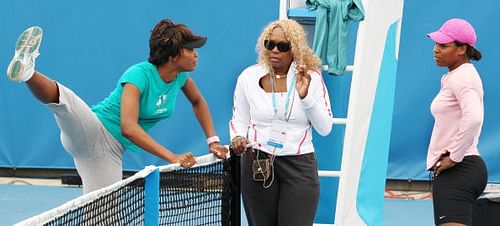
If you wonder how Venus and her sister Serena continue to remain grounded and well-balanced individuals even after all the success and fame they have achieved, you need look no further than their mother, Oracene Price. Oracene said once in an interview, “I always told them you have to stand for something, you have to have some quality in your own life. That’s what makes some athletes more substantial than others.”
While many credit father Richard Williams for being the guiding force behind the success of the Williams sisters, Oracene’s role has been underplayed. When Richard worked on their tennis on the court, Oracene (quoted from Vanguard) “as a mother kept the girls grounded and focused and disciplined. As a nurse, she patched up the girls when they had injuries that had to be kept away from their opponents and the public domain and prepared them for matches. As a social scientist and counsellor, she prepared Venus and Serena to cope with the pressure and challenges on and off the court.”
Oracene is often seen in the stands, watching her daughters play through the dark shades of her sunglasses – applauding a good shot from their opponents – and sometimes “going to sleep,” explaining her sunglasses.
And even after divorcing Richard, Oracene has ensured that their split did not have a detrimental impact on the daughters’ tennis careers. The results are there for all to see. At the age of 31, Serena is still ranked no. 1 and has 15 grand slam singles titles (and 13 doubles slams with Venus). Venus, with seven grand slam singles titles in her bag and still playing with Sjorgen’s Syndrome, is on her way to becoming the elder stateswoman in the game.
Melanie Molitor
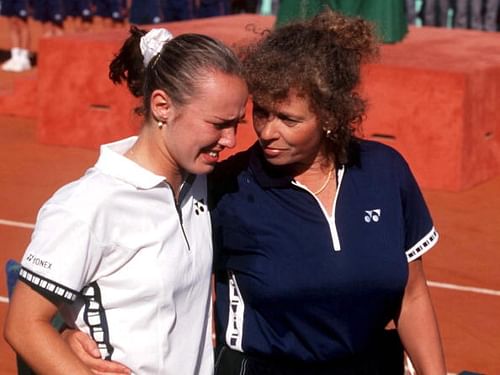
Martina Hingis arrived on the tennis scene as a breath of fresh air. Playing tennis with the hands and the mind of a genius and the personality of a 90s teenager, Hingis’s path to the tennis world was envisioned even while she was in her mother’s womb. Her mother Melanie was a former player herself and played at the same time as the legendary Martina Navratilova. Melanie was not good enough (she was ranked no. 10 in her country), but seeing the success of Navratilova, she decided her daughter would be a tennis champion.
While Melanie did control and discipline Martina when it came to tennis, she did ensure that her daughter did not become a one-dimensional tennis machine. Martina went skating and rode horses and seemed to have a well-blended balance of non-tennis interests even while she was winning slams.
Hingis rocketed to the top of the world rankings at the age of 16, becoming the youngest ever world no. 1 and won 5 grand slam titles by the time she was 18. Then, she found the going tough against the power game of the Williams sisters, Davenport and Capriati. And as Hingis marched into adulthood, her relationship with her also came under pressure as well. Melanie was absent in the stands for the first time during Hingis’s shocking first round exit at Wimbledon in 1999 at the hands of Australian Jelena Dokic and the two severed their coaching relationship in 2001.
The two did mend their relationship later and Melanie accompanied Hingis at some events during her comeback in 2006-2007. Sadly enough, the comeback did not last long or bring in more grand slam glory. Hingis’s career did not end the way Melanie might have envisioned it, but at least she ensured her daughter was able to get everything in life that she herself couldn’t.
Judy Murray
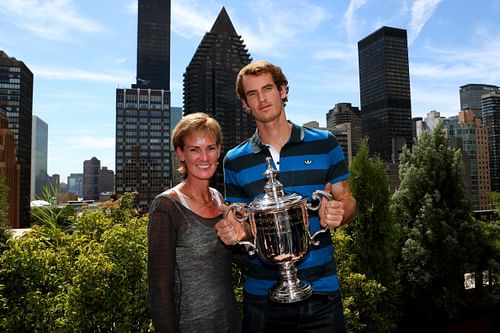
Judy Murray has become an important influential figure in tennis today. But if you thought her only claim to fame was being the mother of Andy Murray and brother Jamie (a mixed doubles grand slam champion), think again. Judy was Scotland’s top player for many years, won 64 Scottish titles and was ranked no. 8 in Britain.
Judy got into coaching early on. Speaking in an interview to The Herald Scotland, Judy says, “My whole life was coaching kids – not just Andy and Jamie – and wanting to make them better. When I was appointed national coach in 1994 [by the Scottish Lawn Tennis Association] I identified about 16 kids, aged between eight and 11. Andy was one, there was Jamie, there was Elena Baltacha, Jamie Baker and others. I drove these kids here, there and everywhere for tournaments, including up and down to England.”
Judy played a dominant role in Andy’s career early on and even received some flak for it. And while Andy now has Ivan Lendl as his coach, Judy is still an integral part of the Murray team. “My mum’s the one person who gets me, who understands me really well,” Murray says.
Judy was also recently appointed the captain for the British Fed Cup team. And even the girls in the team have an immense respect for Judy. Laura Robson had this to say, “Judy was fantastic in Israel and it’s been good here so far. She is very good at technical analysis and we’ve done a lot of that so far. While there is a lot of hard work, she realises it’s important to have a bit of fun and she’s great at building a good atmosphere.” With talented youngsters like Laura Robson and Heather Watson in the team, Judy has the ingredients and the experience to build a Fed Cup winning team in the years to come.